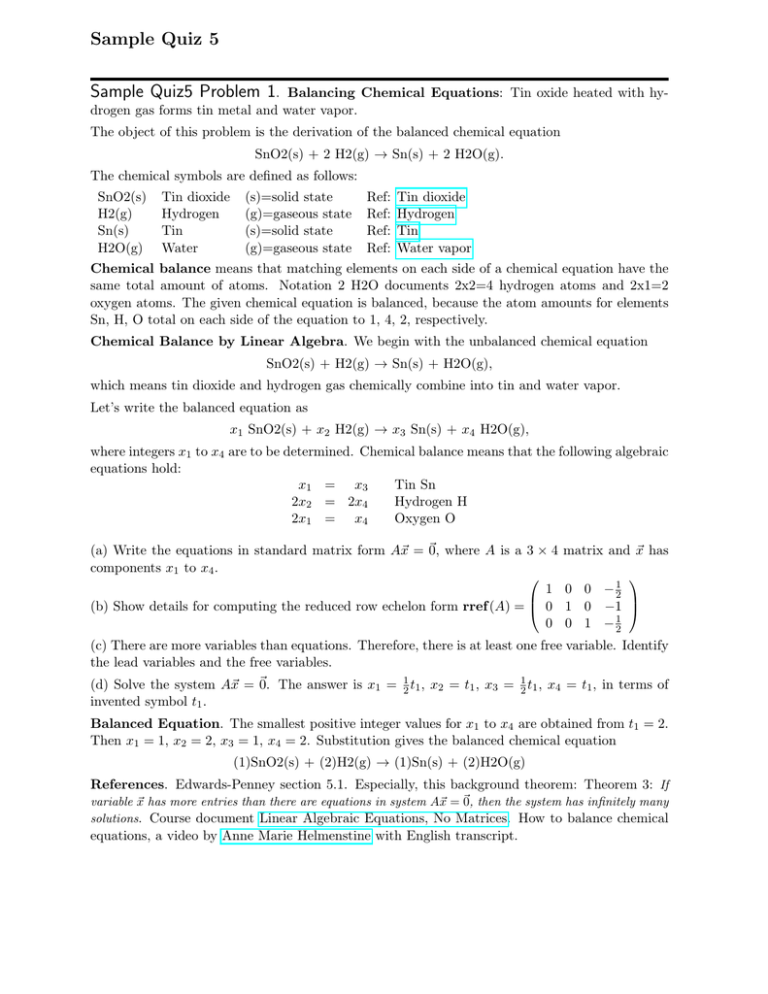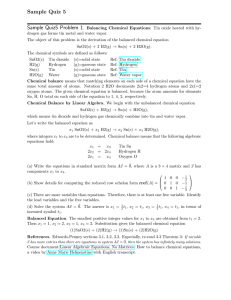Sample Quiz 5 Sample Quiz5 Problem 1
advertisement

Sample Quiz 5 Sample Quiz5 Problem 1. Balancing Chemical Equations: Tin oxide heated with hydrogen gas forms tin metal and water vapor. The object of this problem is the derivation of the balanced chemical equation SnO2(s) + 2 H2(g) → Sn(s) + 2 H2O(g). The chemical symbols are defined as follows: SnO2(s) H2(g) Sn(s) H2O(g) Tin dioxide Hydrogen Tin Water (s)=solid state (g)=gaseous state (s)=solid state (g)=gaseous state Ref: Ref: Ref: Ref: Tin dioxide Hydrogen Tin Water vapor Chemical balance means that matching elements on each side of a chemical equation have the same total amount of atoms. Notation 2 H2O documents 2x2=4 hydrogen atoms and 2x1=2 oxygen atoms. The given chemical equation is balanced, because the atom amounts for elements Sn, H, O total on each side of the equation to 1, 4, 2, respectively. Chemical Balance by Linear Algebra. We begin with the unbalanced chemical equation SnO2(s) + H2(g) → Sn(s) + H2O(g), which means tin dioxide and hydrogen gas chemically combine into tin and water vapor. Let’s write the balanced equation as x1 SnO2(s) + x2 H2(g) → x3 Sn(s) + x4 H2O(g), where integers x1 to x4 are to be determined. Chemical balance means that the following algebraic equations hold: x1 = x3 Tin Sn 2x2 = 2x4 Hydrogen H 2x1 = x4 Oxygen O (a) Write the equations in standard matrix form A~x = ~0, where A is a 3 × 4 matrix and ~x has components x1 to x4 . 1 0 0 − 21 (b) Show details for computing the reduced row echelon form rref (A) = 0 1 0 −1 0 0 1 − 12 (c) There are more variables than equations. Therefore, there is at least one free variable. Identify the lead variables and the free variables. (d) Solve the system A~x = ~0. The answer is x1 = 12 t1 , x2 = t1 , x3 = 12 t1 , x4 = t1 , in terms of invented symbol t1 . Balanced Equation. The smallest positive integer values for x1 to x4 are obtained from t1 = 2. Then x1 = 1, x2 = 2, x3 = 1, x4 = 2. Substitution gives the balanced chemical equation (1)SnO2(s) + (2)H2(g) → (1)Sn(s) + (2)H2O(g) References. Edwards-Penney section 5.1. Especially, this background theorem: Theorem 3: If variable ~x has more entries than there are equations in system A~x = ~0, then the system has infinitely many solutions. Course document Linear Algebraic Equations, No Matrices. How to balance chemical equations, a video by Anne Marie Helmenstine with English transcript. Sample Quiz5 Problem 2. Solving Higher Order Initial Value Problems with Linear Algebra. The objective of this problem is to learn how to solve for the constants in a general solution, using given initial conditions. The differential equation and its known general solution are y 000 + 4y 00 = 0, y(x) = c1 + c2 x + c3 e−4x . The initial conditions are y(0) = 1, y 0 (0) = 2, y 00 (0) = −1. (a) Derive the general solution formula, as follows. Make the substitution v = y 00 to obtain v 0 + 4v = 0. Solve for v and then integrate twice to find y. (b) Substitute the general solution into the three initial conditions to obtain the system of equations 1 c1 1 0 1 0 1 −4 c2 = 2 −1 c3 0 0 16 (c) Solve the system of equations and then report the particular solution y(x) so found. Remark.Picard’s existence-uniqueness theorem says that the initial value problem has a unique solution, meaning that the linear algebra problem is in the unique solution case: no free variable. References. Edwards-Penney sections 3.3, 3.4, 5.3. Course manuscript Linear Algebraic Equations, No Matrices. Sample Quiz5 Problem 3. An RL-Circuit with DC Voltage Source. The RL-circuit in the figure has model LI 0 + RI = Vs where symbols L, R, Vs are constants. If the charge is Q(t), then I = Q0 and LQ00 + RQ0 = Vs . Differentiate this equation to obtain LQ000 + RQ00 = 0. Assume the current and charge are initially zero, before the switch is closed. (a) Explain why Q has initial conditions Q(0) = Q0 (0) = 0, Q00 (0) = Vs /L. (b) Solve for the charge Q(t) and current I(t) from the higher order equation LQ000 + RQ00 = 0 with initial conditions Q(0) = Q0 (0) = 0, Q00 (0) = Vs /L, guided by Problem 2, above. The system of linear equations to be solved is 1 0 0 1 0 0 c1 0 c2 = −R 0 . L 2 1 R L2 c3 Vs L (c) The steady-state current limt→∞ I(t) computed directly from your solution formula should equal the answer from the equilibrium solution of LI 0 + RI = Vs . Does it? References. Edwards-Penney sections 3.7, 4.1, 5.1. Course manuscript Linear Algebraic Equations, No Matrices. Edwards-Penney BVP 3.7, electric circuit supplement. All About Circuits Volume I – DC by T. Kuphaldt. Course slides on Electric Circuits.
